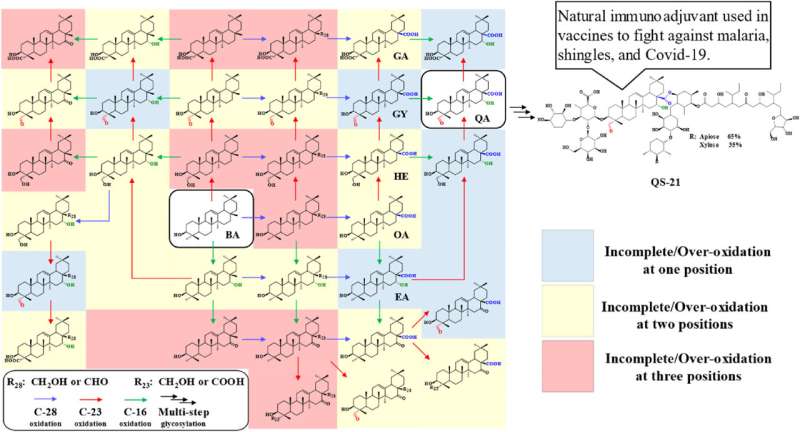This article has been reviewed according to Science X's editorial process and policies. Editors have highlighted the following attributes while ensuring the content's credibility:
fact-checked
trusted source
proofread
Optimizing cytochrome P450 network for high-level production of quillaic acid

Researchers from the Shenzhen Institute of Advanced Technology of the Chinese Academy of Sciences have developed a combinatorial optimization approach to construct and spatially control a cytochrome P450-cytochrome P450 reductase (CYP-CPR) network in an engineered Saccharomyces cerevisiae strain to boost quillaic acid production.
The study was published in Metabolic Engineering on Sept. 12.
Cytochrome P450s (CYPs) play versatile roles in nature, which makes them an important tool in synthetic biology for building microbial cell factories to produce commercially valuable pharmaceuticals, such as saponins. However, CYPs exhibit substrate promiscuity and oxidize unintended substrates, leading to accumulation of under-oxidized or over-oxidized products not recognized by other co-expressed CYPs.
Quillaic acid is the aglycone backbone for 49 out of 58 saponins identified in Quillaja saponaria Molina, some of which have been used as adjuvants in malaria, shingles, and COVID-19 vaccines.
De novo biosynthesis of quillaic acid in a microbial cell factory requires multiple CYPs to catalyze the six-step oxidation at three different positions. Maintaining the oxidation steps in absolute synergy is crucial, because 47 different products could be formed during the process, of which 46 are either incomplete or over oxidized by-products.
In this study, the researchers established an efficient network of CYPs and CPRs through iterative screening of more than 100 CYP-CPR pairs to produce the target product quillaic acid.
The spatial distance between different CYPs on the endoplasmic reticulum was controlled by expression of membrane steroid-binding protein 1 from Arabidopsis thaliana, which increased quillaic acid titer by 79.5%.
They optimized the enzyme network in the microbial cell factory by strengthening co-factor supply and augmenting endoplasmic reticulum surface. Out of 47 potential products that could be synthesized, 86% of the products synthesized by the optimized enzyme network was the target compound quillaic acid, and fermentation achieved 2.23 g/L quillaic acid.
More information: Jiazeng Yang et al, Combinatorial optimization and spatial remodeling of CYPs to control product profile, Metabolic Engineering (2023). DOI: 10.1016/j.ymben.2023.09.004
Provided by Chinese Academy of Sciences





















